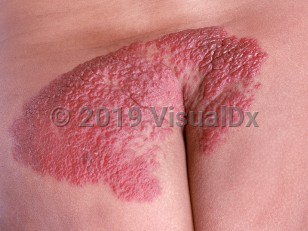Lumbosacral infantile hemangioma is associated with a high frequency of spinal dysraphism (defective fusion of the neural tube leading to spinal or bony abnormalities). The best data are retrospective and focus on lesions larger than 2.5 cm in diameter overlying the lumbar or sacral spine. About 50% of lesions this size had associated spinal cord abnormalities including lipomas, tethering, and intraspinal hemangiomas. All of these lesions, possibly reflecting selection bias, had associated spinal dysraphism. Lipomas, tethered spinal cord, and intraspinal hemangiomas were associated with the cutaneous lesions. Port-wine stains are not included.
Syndromes associated with hemangiomas in this region of the body include:
- PELVIS syndrome (perineal hemangioma, extragenital malformations, lipomyelomeningocele, vesicorenal abnormalities, imperforate anus, and skin tag)
- LUMBAR syndrome (lower body hemangioma and other cutaneous defects, urogenital anomalies, ulceration, myelopathy, bony deformities, anorectal malformations, arterial anomalies, and renal anomalies)
Related topics: infantile hemangioma, lumbosacral skin lesion, spina bifida



